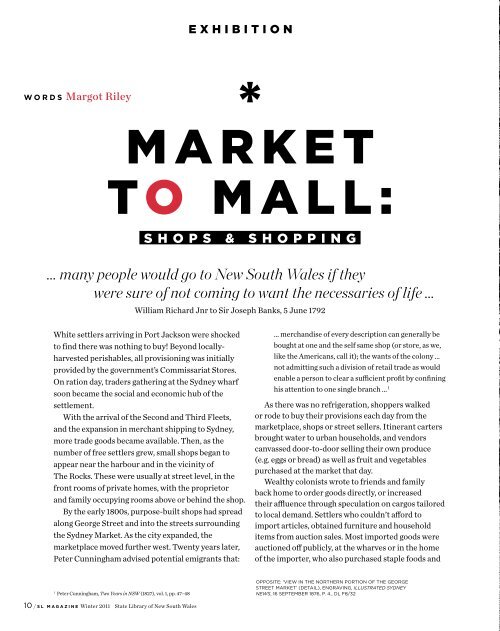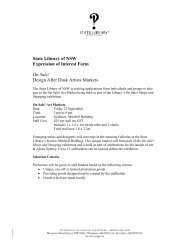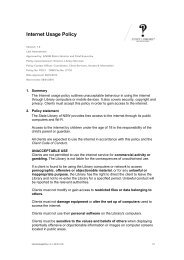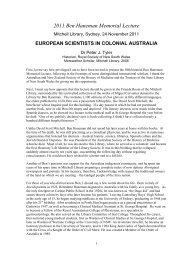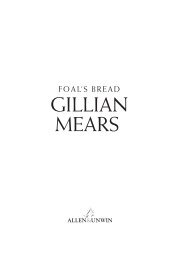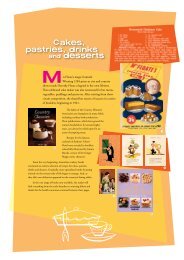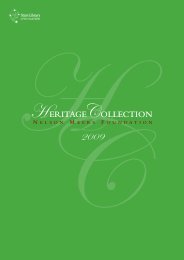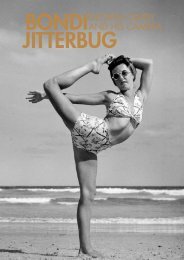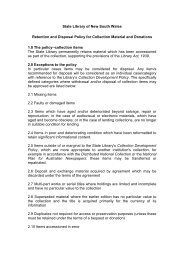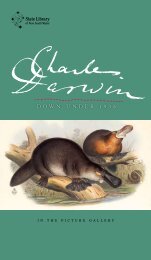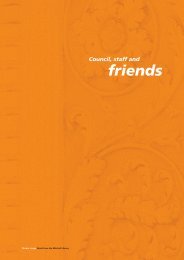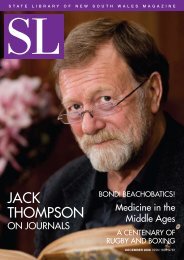SL Magazine Winter 2011 - State Library of New South Wales
SL Magazine Winter 2011 - State Library of New South Wales
SL Magazine Winter 2011 - State Library of New South Wales
You also want an ePaper? Increase the reach of your titles
YUMPU automatically turns print PDFs into web optimized ePapers that Google loves.
e x h i b i t i o N<br />
W o r d s Margot Riley<br />
*<br />
M a r k e t <br />
to M a l l : <br />
s h o p s & s h o p p i N g<br />
... many people would go to <strong>New</strong> <strong>South</strong> <strong>Wales</strong> if they<br />
were sure <strong>of</strong> not coming to want the necessaries <strong>of</strong> life ...<br />
William Richard Jnr to Sir Joseph Banks, 5 June 1792<br />
White settlers arriving in Port Jackson were shocked<br />
to find there was nothing to buy! Beyond locallyharvested<br />
perishables, all provisioning was initially<br />
provided by the government’s Commissariat Stores.<br />
On ration day, traders gathering at the Sydney wharf<br />
soon became the social and economic hub <strong>of</strong> the<br />
settlement.<br />
With the arrival <strong>of</strong> the Second and Third Fleets,<br />
and the expansion in merchant shipping to Sydney,<br />
more trade goods became available. Then, as the<br />
number <strong>of</strong> free settlers grew, small shops began to<br />
appear near the harbour and in the vicinity <strong>of</strong><br />
The Rocks. These were usually at street level, in the<br />
front rooms <strong>of</strong> private homes, with the proprietor<br />
and family occupying rooms above or behind the shop.<br />
By the early 1800s, purpose-built shops had spread<br />
along George Street and into the streets surrounding<br />
the Sydney Market. As the city expanded, the<br />
marketplace moved further west. Twenty years later,<br />
Peter Cunningham advised potential emigrants that:<br />
... merchandise <strong>of</strong> every description can generally be<br />
bought at one and the self same shop (or store, as we,<br />
like the Americans, call it); the wants <strong>of</strong> the colony …<br />
not admitting such a division <strong>of</strong> retail trade as would<br />
enable a person to clear a suffcient pr<strong>of</strong>it by confining<br />
his attention to one single branch ... 1<br />
As there was no refrigeration, shoppers walked<br />
or rode to buy their provisions each day from the<br />
marketplace, shops or street sellers. Itinerant carters<br />
brought water to urban households, and vendors<br />
canvassed door-to-door selling their own produce<br />
(e.g. eggs or bread) as well as fruit and vegetables<br />
purchased at the market that day.<br />
Wealthy colonists wrote to friends and family<br />
back home to order goods directly, or increased<br />
their affuence through speculation on cargos tailored<br />
to local demand. Settlers who couldn’t afford to<br />
import articles, obtained furniture and household<br />
items from auction sales. Most imported goods were<br />
auctioned <strong>of</strong>f publicly, at the wharves or in the home<br />
<strong>of</strong> the importer, who also purchased staple foods and<br />
opposiTe: ‘VieW in The norThern porTion <strong>of</strong> The george<br />
sTreeT markeT’ (deTail), engraVing, illustRated sydney<br />
1<br />
Peter Cunningham, Two Years in NSW (1827), vol. 1, pp. 47–48 neWs, 16 sepTember 1876, p. 4., dl f8/32<br />
10 / s L m a g a z i n E <strong>Winter</strong> <strong>2011</strong> <strong>State</strong> <strong>Library</strong> <strong>of</strong> <strong>New</strong> <strong>South</strong> <strong>Wales</strong>


